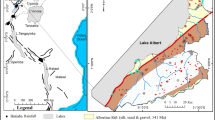Abstract
Groundwater contamination characteristics and the potential fate of chlorohydrocarbons were investigated at a combined polluted groundwater site in North China. Groundwater chemistry and 2D and 18O isotope compositions indicated that high salination of groundwater was related with chemical pollution. The elevated salinity plume was consistent with the domain where typical chlorohydrocarbon contaminants occurred. The concentrations of heavy metals, oxidation–reduction potential, and pH in organic polluted areas significantly differed from those in peripheral (background) areas, indicating modified hydrochemistry possibly resulting from organic pollution. Under the presented redox conditions of groundwater, monochlorobenzene oxidation may have occurred when the trichlorohydrocarbons underwent reductive dechlorination. These findings suggested that inorganic hydrochemistry effectively indicated the occurrence of chemical contamination in groundwater and the potential fate of chlorohydrocarbons.




Similar content being viewed by others
References
Appelo CAJ, Postma DJ (2005) Geochemistry, groundwater and pollution, 2nd edn. Taylor & Francis, Rotterdam
Dekker TJ, Abriola LM (2000) The influence of field-scale heterogeneity on the infiltration and entrapment of dense nonaqueous phase liquids in saturated formations. J Contam Hydrol 42(2–4):187–218. doi:10.1016/S0169-7722(99)00092-3
EPIsuite v4.0 [CP] (2011) (EPIWIN), EPA’s Office of Pollution Prevention Toxics, Syracuse Research Corporation (SRC). http://www.epa.gov/opptintr/exposure/pubs/episuitedl.htm
Huang S, Wang Y, Cao L, Pi K, Yu M, Even E (2012) Multidimensional spectrofluorometry characterization of dissolved organic matter in arsenic-contaminated shallow groundwater. J Environ Sci Health A 47(10):1446–1454. doi:10.1080/10934529.2012.672390
IPCS (1991) Chlorobenzenes other than hexachlorobenzene. World Health Organization, International Programme on Chemical Safety (Environmental Health Criteria 128), Geneva
Lawrence SJ (2006) Description, properties, and degradation of selected volatile organic compounds detected in ground water—a review of selected literature: Atlanta, Georgia, U.S. Geological Survey, Open-File Report 2006–1338, 62 pp. http://pubs.usgs.gov/ofr/2006/1338/
Lide DR (ed) (2007) Physical constants of organic compounds. In: handbook of chemistry and physics, internet version, 87th edn. Taylor and Francis, Boca Raton, pp 15-14–15-21
PRC Ministry of Health and Standardization Administration (2006) Standards for drinking water quality (GB 5749–2006). China Standard Press, Beijing (in Chinese)
Rivett MO, Turner RJ, Glibbery P, Cuthbert MO (2012) The legacy of chlorinated solvents in the Birmingham aquifer, UK: observations spanning three decades and the challenge of future urban groundwater development. J Contam Hydrol 140–141:107–123. doi:10.1016/j.jconhyd.2012.08.006
Sander Peter, Wittaich RM, Peter F, Heinz W, Wittko F (1991) Degradation of 1,2,4-trichloro and 1,2,4,5-tetrachlorobenzene by Pseudomonas strains. Appl Environ Microbiol 57(5):1430–1440
Stroo HF, Leeson A, Marqusee JA, Johnson PC, Ward CH, Kavanaugh MC, Sale TC, Newell CJ, Pennell KD, Lebron CA, Unger M (2012) Chlorinated ethene source remediation: lessons learned. Environ Sci Technol 46(12):6438–6447. doi:10.1021/es204714w
Stumm W, Morgan JJ (1996) Aquatic chemistry: chemical equilibria and rates in natural waters, 3rd edn. Wiley, New York
US Environmental Protection Agency (2009) List of contaminants and their MCLs. EPA 816-F-09-0004. http://water.epa.gov/drink/contaminants/index.cfm#List
US National Research Council (2004) Contaminants in the subsurface: source zone assessment and remediation. National Academy Press, Washington. http://www.nap.edu
Zhang ZJ, Fei YH, Chen ZY, Zhao ZZ, Xie ZH, Wang YB, Miao JX, Yang LZ, Shao JL, Jin MG, Xu GM, Yang QQ et al (2009) Investigation and assessment of sustainable utilization of groundwater resources in the North China Plain, 1st edn. Geological Publishing House, Beijing (in Chinese with English abstract)
Zhang E, Wang Y, Qian Y, Ma T, Zhang D, Zhan H, Zhang Z, Fei Y, Wang S (2013) Iodine in groundwater of the North China Plain: spatial patterns and hydrogeochemical processes of enrichment. J Geochem Explor 135:40–53. doi:10.1016/j.gexplo.2012.11.016
Zogorski JS, Carter JM, Ivahnenko T, Lapham WW, Moran MJ, Rowe BL, Squillace PJ, Toccalino PL (2006) The quality of our Nation’s waters—volatile organic compounds in the Nation’s ground water and drinking-water supply wells: U.S. Geological Survey Circular 1292, 101 p
Acknowledgments
This research was financially supported by the National Natural Science Foundation of China (41302187), China Post-doctoral Science Foundation (2014M552105), the Institute of Hydrogeology and Environmental Geology, Chinese Academy of Geological Sciences (SK201303, SK201412), and the Chinese Geological Survey (12120113102700).
Author information
Authors and Affiliations
Corresponding authors
Rights and permissions
About this article
Cite this article
Huang, Sb., Han, Zt., Zhao, L. et al. Hydrochemistry Indicating Groundwater Contamination and the Potential Fate of Chlorohydrocarbons in Combined Polluted Groundwater: A Case Study at a Contamination Site in North China. Bull Environ Contam Toxicol 94, 589–597 (2015). https://doi.org/10.1007/s00128-015-1513-9
Received:
Accepted:
Published:
Issue Date:
DOI: https://doi.org/10.1007/s00128-015-1513-9




